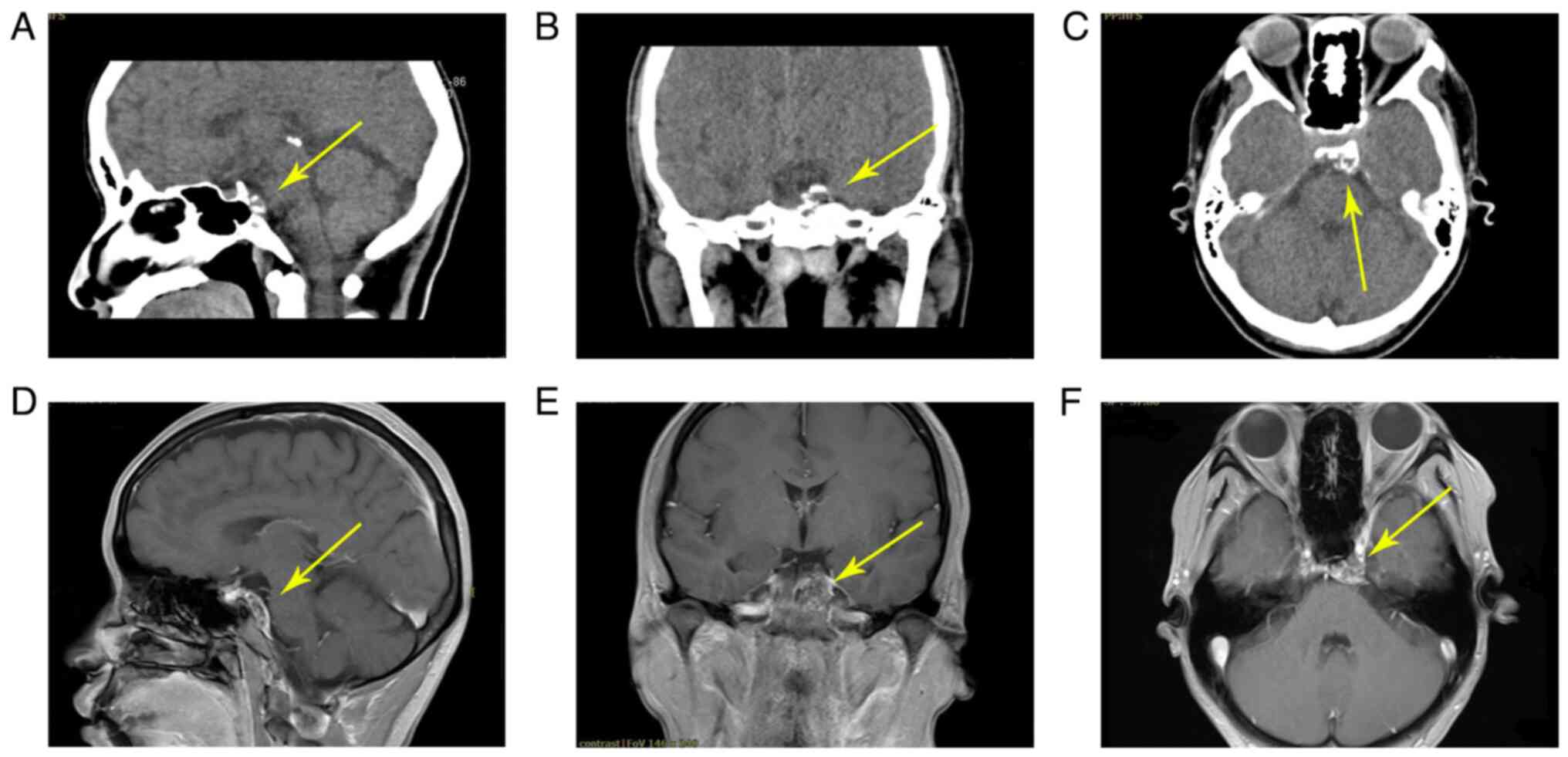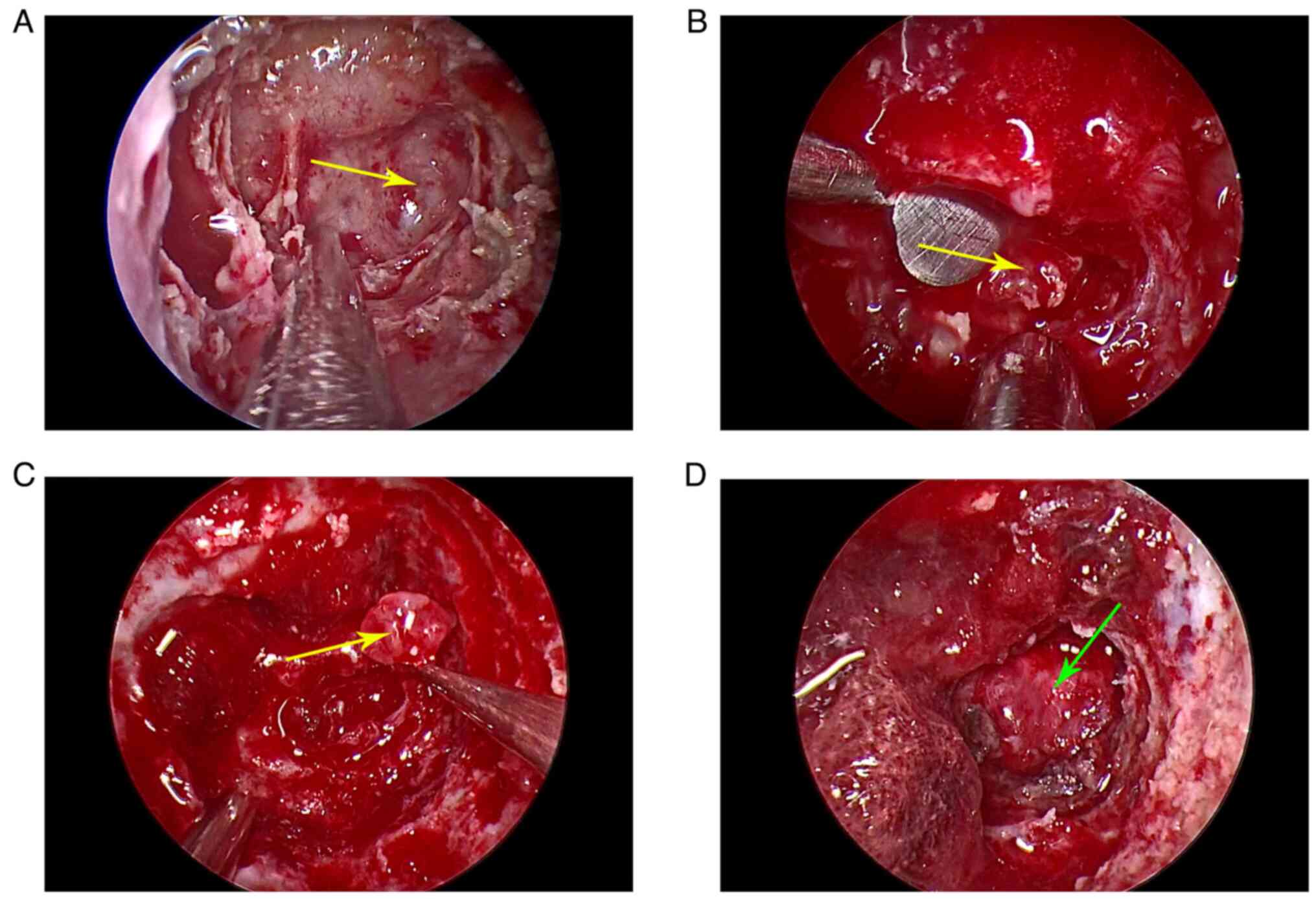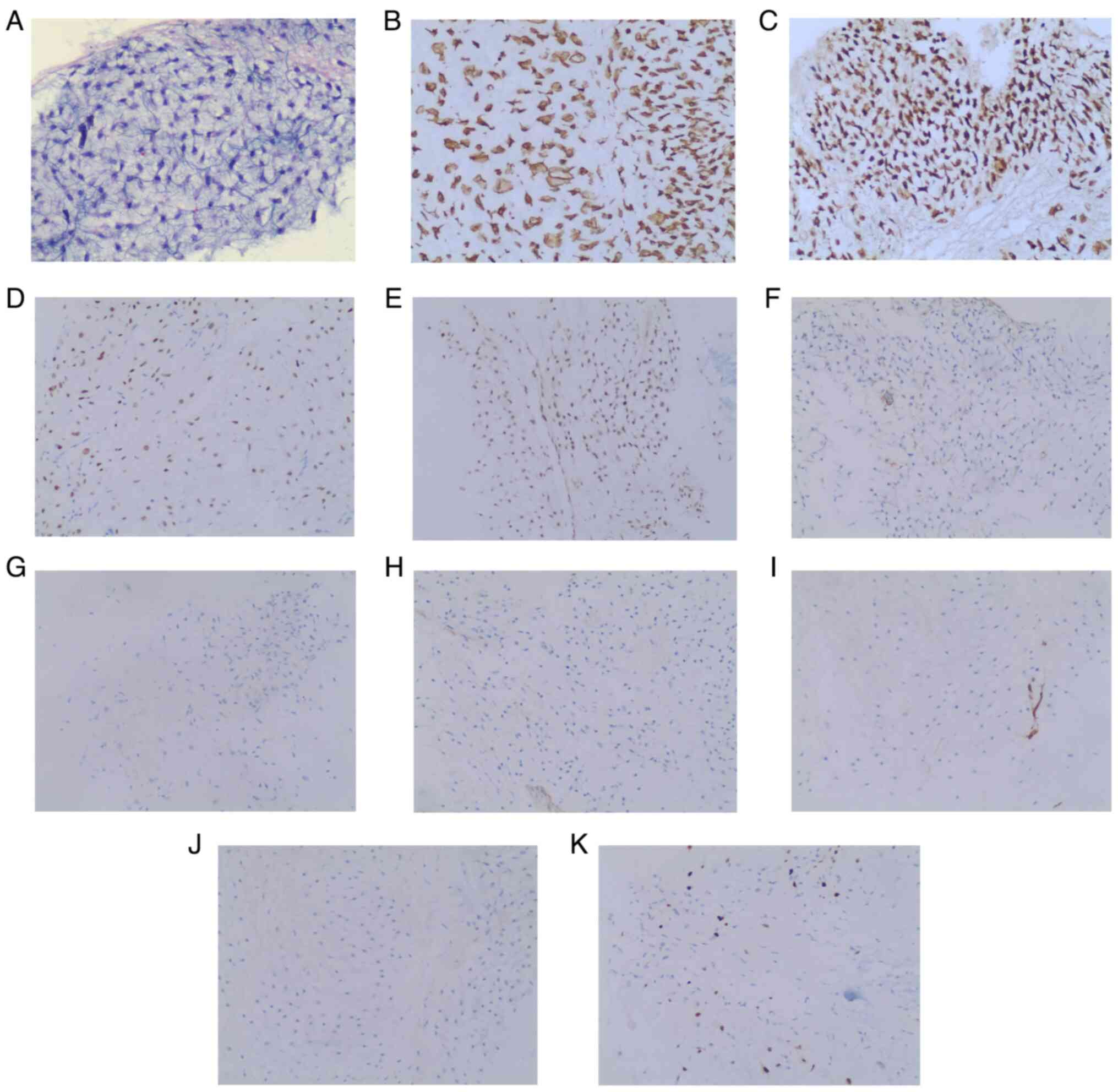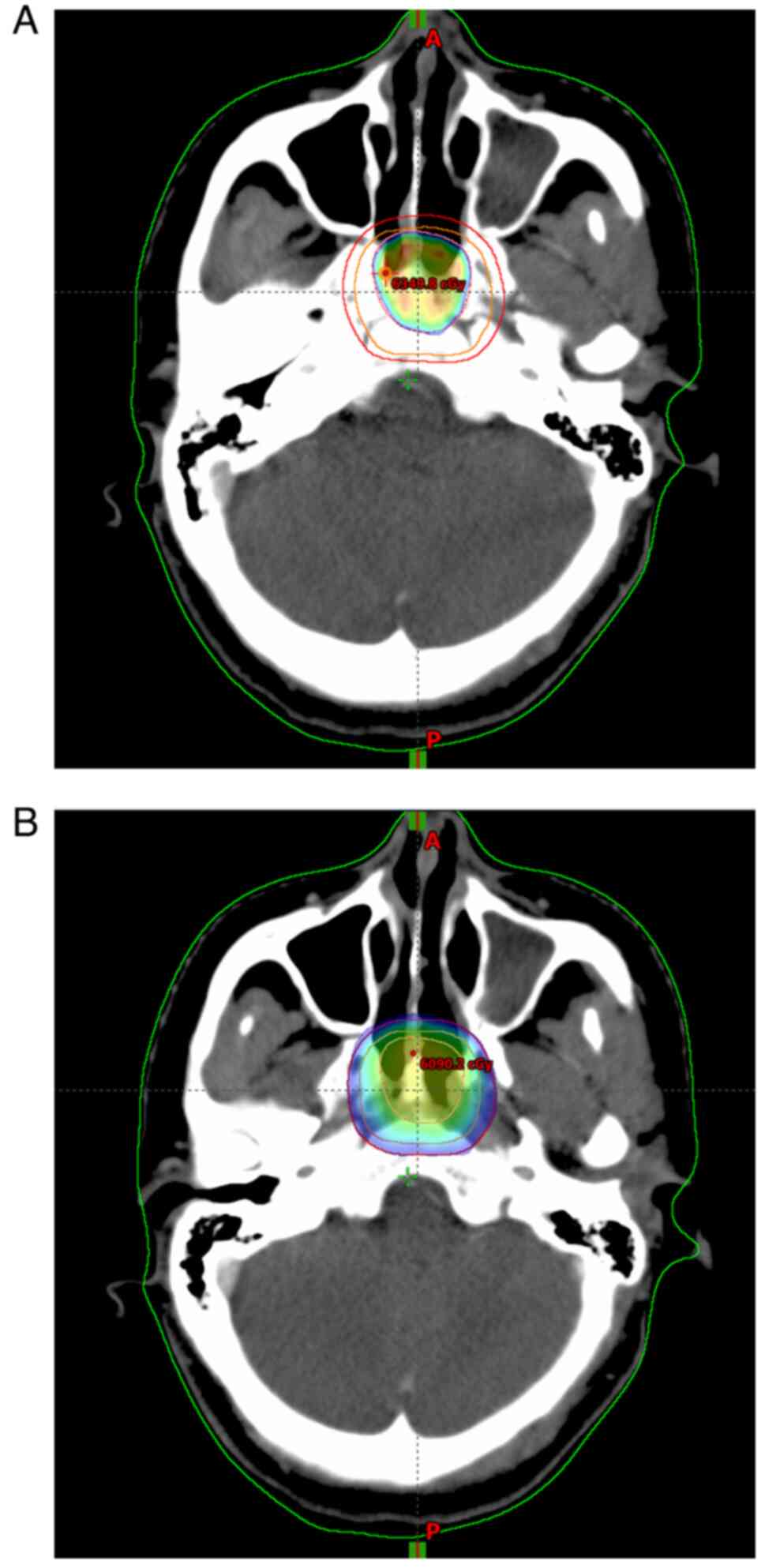|
1
|
Oghalai JS, Buxbaum JL, Jackler RK and
McDermott MW: Skull base chondrosarcoma originates from the
petroclival junction. Otol Neurotol. 26:1052–1060. 2005. View Article : Google Scholar : PubMed/NCBI
|
|
2
|
Cianfriglia F, Pompili A and Occhipinti E:
Intracranial malignant cartilaginous tumors. Report of two cases
and review of literature. Acta Neurochir (Wien). 45:163–175. 1978.
View Article : Google Scholar : PubMed/NCBI
|
|
3
|
Richardson MS: Pathology of skull base
tumors. Otolaryngol Clin North Am. 34:1025–1042. 2001. View Article : Google Scholar : PubMed/NCBI
|
|
4
|
Kremenevski N, Schlaffer SM, Coras R,
Kinfe TM, Graillon T and Buchfelder M: Skull base chordomas and
chondrosarcomas. Neuroendocrinology. 110:836–847. 2020. View Article : Google Scholar : PubMed/NCBI
|
|
5
|
Edem I, DeMonte F and Raza SM: Advances in
the management of primary bone sarcomas of the skull base. J
Neurooncol. 150:393–403. 2020. View Article : Google Scholar : PubMed/NCBI
|
|
6
|
Alamer OB, Haider AS, Haider M, Sagoo NS,
Robertson FC, Arrey EN, Aoun SG, Yu K, Cohen-Gadol AA and El
Ahmadieh TY: Primary and radiation induced skull base osteosarcoma:
A systematic review of clinical features and treatment outcomes. J
Neurooncol. 153:183–202. 2021. View Article : Google Scholar
|
|
7
|
Oot RF, Melville GE, New PF,
Austin-Seymour M, Munzenrider J, Pile-Spellman J, Spagnoli M,
Shoukimas GM, Momose KJ and Carroll R: The role of MR and CT in
evaluating clival chordomas and chondrosarcomas. AJR Am J
Roentgenol. 151:567–575. 1988. View Article : Google Scholar : PubMed/NCBI
|
|
8
|
Müller U, Kubik-Huch RA, Ares C, Hug EB,
Löw R, Valavanis A and Ahlhelm FJ: Is there a role for conventional
MRI and MR diffusion-weighted imaging for distinction of skull base
chordoma and chondrosarcoma? Acta Radio. l57:225–232. 2016.
View Article : Google Scholar
|
|
9
|
Welzel T, Meyerhof E, Uhl M, Huang K, von
Deimling A, Herfarth K and Debus J: Diagnostic accuracy of DW MR
imaging in the differentiation of chordomas and chondrosarcomas of
the skull base: A 3.0-T MRI study of 105 cases. Eur J Radiol.
105:119–124. 2018. View Article : Google Scholar : PubMed/NCBI
|
|
10
|
Doucet V, Peretti-Viton P,
Figarella-Branger D, Manera L and Salamon G: MRI of intracranial
chordomas. Extent of tumour and contrast enhancement: Criteria for
differential diagnosis. Neuroradiology. 39:571–576. 1997.
View Article : Google Scholar : PubMed/NCBI
|
|
11
|
Fu LY, Han Q, Cheng P, Yang HJ and Zhao Y:
Rare case report and literature review of intracranial mesenchymal
chondrosarcoma. Ann Palliat Med. 10:12012–12017. 2021. View Article : Google Scholar : PubMed/NCBI
|
|
12
|
Limaiem F, Davis DD and Sticco KL:
Chondrosarcoma. In: StatPearls [Internet]. Treasure Island (FL):
StatPearls Publishing; 2023
|
|
13
|
Paulus W, Slowik F and Jellinger K:
Primary intracranial sarcomas: Histopathological features of 19
cases. Histopathology. 18:395–402. 1991. View Article : Google Scholar : PubMed/NCBI
|
|
14
|
Zhang Y, Huang J, Zhang C, Jiang C, Ding
C, Lin Y, Wu X, Wang C, Kang D and Lin Z: An extended endoscopic
endonasal approach for sellar area chondrosarcoma: A case report
and literature review. World Neurosurg. 127:469–477. 2019.
View Article : Google Scholar : PubMed/NCBI
|
|
15
|
Mott FW: Chondrosarcoma springing from the
sella turcica. Arch Neurol Psychiat. 1:432–433. 1899.
|
|
16
|
Abhinav K, Acosta Y, Wang WH, Bonilla LR,
Koutourousiou M, Wang E, Synderman C, Gardner P and
Fernandez-Miranda JC: Endoscopic endonasal approach to the optic
canal: Anatomic considerations and surgical relevance.
Neurosurgery. 11 (Suppl 3):S431–S445. 2015.
|
|
17
|
Arbolay OL, González JG, González RH and
Gálvez YH: Extended endoscopic endonasal approach to the skull
base. Minim Invasive Neurosurg. 52:114–118. 2009. View Article : Google Scholar : PubMed/NCBI
|
|
18
|
Oghalai JS, Buxbaum JL, Jackler RK and
McDermott MW: Skull base chondrosarcoma originating from the
petroclival junction. Otol Neurotol. 26:1052–1060. 2005. View Article : Google Scholar : PubMed/NCBI
|
|
19
|
Korten AG, ter Berg HJ, Spincemaille GH,
van der Laan RT and Van de Wel AM: Intracranial chondrosarcoma:
Review of the literature and report of 15 cases. J Neurol Neurosurg
Psychiatry. 65:88–92. 1998. View Article : Google Scholar : PubMed/NCBI
|
|
20
|
Marshman LA, Gunasekera L, Rose PE and
Olney JS: Primary intracerebral mesenchymal chondrosarcoma with
rhabdomyosarcomatous differentiation: Case report and literature
review. Br J Neurosurg. 15:419–424. 2001. View Article : Google Scholar : PubMed/NCBI
|
|
21
|
Li YH and Yao XH: Primary intradural
mesenchymal chondrosarcoma of the spine in a child. Pediatr Radiol.
37:1155–1158. 2007. View Article : Google Scholar : PubMed/NCBI
|
|
22
|
Sindou M, Daher A, Vighetto A and Goutelle
A: Parasellar chondrosarcoma: Report of a case operated on through
a pteriono-temporal approach and review of the literature.
Neurochirurgie. 5:186–190. 1989.(In French).
|
|
23
|
Bloch OG, Jian BJ, Yang I, Han SJ, Aranda
D, Ahn BJ and Parsa AT: A systematic review of intracranial
chondrosarcoma and survival. J Clin Neurosci. 16:1547–1551. 2009.
View Article : Google Scholar : PubMed/NCBI
|
|
24
|
Güneş M, Günaldi O, Tuğcu B, Tanriverdi O,
Güler AK and Cöllüoğlu B: Intracranial chondrosarcoma: A case
report and review of the literature. Minim Invasive Neurosurg.
52:238–241. 2009. View Article : Google Scholar : PubMed/NCBI
|
|
25
|
Chen F, Chen B, Wang H, Xu W, Li W and
Chen D: Intracranial nonskull-based chondrosarcoma arising from the
sagittal sinus: A case report and review of the literature. World
Neurosurg. 120:234–239. 2018. View Article : Google Scholar : PubMed/NCBI
|
|
26
|
Abele TA, Yetkin ZF, Raisanen JM, Mickey
BE and Mendelsohn DB: Non-pituitary origin sellar tumours mimicking
pituitary macroadenomas. Clin Radiol. 67:821–827. 2012. View Article : Google Scholar : PubMed/NCBI
|
|
27
|
Chu J, Ma H, Wang Y, Li K, Liao C and Ding
Y: CT and MRI findings of intracranial extraskeletal mesenchymal
chondrosarcoma-a case report and literature review. Transl Cancer
Res. 11:3409–3415. 2022. View Article : Google Scholar : PubMed/NCBI
|
|
28
|
Cho BK, Chi JG, Wang KC, Chang KH and Choi
KS: Intracranial mesenchymal chondrosarcoma: A case report and
literature review. Childs Nerv Syst. 9:295–299. 1993. View Article : Google Scholar : PubMed/NCBI
|
|
29
|
Lee YY, Van Tassel P and Raymond AK:
Intracranial dural chondrosarcoma. AJNR Am J Neuroradiol.
9:1189–1193. 1988.PubMed/NCBI
|
|
30
|
Bingaman KD, Alleyne CH Jr and Olson JJ:
Intracranial extraskeletal mesenchymal chondrosarcoma: Case report.
Neurosurgery. 46:207–211. 2000. View Article : Google Scholar : PubMed/NCBI
|
|
31
|
Kothary N, Law M, Cha S and Zagzag D:
Conventional and perfusion MR imaging of parafalcine
chondrosarcoma. AJNR Am J Neuroradiol. 24:245–248. 2003.PubMed/NCBI
|
|
32
|
Tauber M, van Loveren HR, Jallo G, Romano
A and Keller JT: The enigmatic foramen lacerum. Neurosurgery.
44:386–391. 1999. View Article : Google Scholar : PubMed/NCBI
|
|
33
|
Rich TA, Schiller A, Suit HD and Mankin
HJ: Clinical and pathologic review of 48 cases of chordoma. Cancer.
56:182–187. 1985. View Article : Google Scholar : PubMed/NCBI
|
|
34
|
Chandler JP, Yashar P, Laskin WB and
Russell EJ: Intracranial chondrosarcoma: A case report and review
of the literature. J Neurooncol. 68:33–39. 2004. View Article : Google Scholar : PubMed/NCBI
|
|
35
|
Bloch OG, Jian BJ, Yang I, Han SJ, Aranda
D, Ahn BJ and Parsa AT: Cranial chondrosarcoma and recurrence.
Skull Base. 20:149–156. 2010. View Article : Google Scholar : PubMed/NCBI
|
|
36
|
Palmisciano P, Haider AS, Sabahi M, Nwagwu
CD, Bin Alamer O, Scalia G, Umana GE, Cohen-Gadol AA, El Ahmadieh
TY, Yu K and Pathmanaban ON: Primary skull base chondrosarcomas: A
systematic review. Cancers (Basel). 13:59602021. View Article : Google Scholar : PubMed/NCBI
|
|
37
|
Adappa ND, Learned KO, Palmer JN, Newman
JG and Lee JY: Radiographic enhancement of the nasoseptal flap does
not predict postoperative cerebrospinal fluid leaks in endoscopic
skull base reconstruction. Laryngoscope. 122:1226–1234. 2012.
View Article : Google Scholar : PubMed/NCBI
|
|
38
|
Cavallo LM, de Divitiis O, Aydin S,
Messina A, Esposito F, Iaconetta G, Talat K, Cappabianca P and
Tschabitscher M: Extended endoscopic endonasal transsphenoidal
approach to the suprasellar area: Anatomic considerations-part 1.
Neurosurgery. 61:24–33. 2007.PubMed/NCBI
|
|
39
|
Kassam AB, Prevedello DM, Carrau RL,
Snyderman CH, Gardner P, Osawa S, Seker A and Rhoton AL Jr: The
front door to meckel's cave: An anteromedial corridor via expanded
endoscopic endonasal approach- technical considerations and
clinical series. Neurosurgery. 64:on71–82. 2009.
|
|
40
|
Jho HD and Carrau RL: Endoscopy assisted
transsphenoidal surgery for pituitary adenoma. Technical note. Acta
Neurochir (Wien). 138:1416–1425. 1996. View Article : Google Scholar : PubMed/NCBI
|
|
41
|
Osawa S, Rhoton AL Jr, Seker A, Shimizu S,
Fujii K and Kassam AB: Microsurgical and endoscopic anatomy of the
vidian canal. Neurosurgery. 64 (5 Suppl 2):S385–S411. 2009.
|
|
42
|
Hasegawa H, Shin M, Kondo K, Hanakita S,
Mukasa A, Kin T and Saito N: Role of endoscopic transnasal surgery
for skull base chondrosarcoma: A retrospective analysis of 19 cases
at a single institution. J Neurosurg. 128:1438–1447. 2018.
View Article : Google Scholar : PubMed/NCBI
|
|
43
|
Tzortzidis F, Elahi F, Wright DC, Temkin
N, Natarajan SK and Sekhar LN: Patient outcome at long-term
follow-up after aggressive microsurgical resection of cranial base
chondrosarcomas. Neurosurgery. 58:1090–1098. 2006. View Article : Google Scholar : PubMed/NCBI
|
|
44
|
Kano H, Sheehan J, Sneed PK, McBride HL,
Young B, Duma C, Mathieu D, Seymour Z, McDermott MW, Kondziolka D,
et al: Skull base chondrosarcoma radiosurgery: Report of the North
American gamma knife consortium. J Neurosurg. 123:1268–1275. 2015.
View Article : Google Scholar : PubMed/NCBI
|
|
45
|
Feuvret L, Bracci S, Calugaru V, Bolle S,
Mammar H, De Marzi L, Bresson D, Habrand JL, Mazeron JJ, Dendale R
and Noël G: Efficacy and safety of adjuvant proton therapy combined
with surgery for chondrosarcoma of the skull base: A retrospective,
population-based study. Int J Radiat Oncol Biol Phys. 95:312–321.
2016. View Article : Google Scholar : PubMed/NCBI
|
|
46
|
Suit HD, Goitein M, Munzenrider J, Verhey
L, Urie M, Gragoudas E, Koehler A, Gottschalk B, Sisterson J and
Tatsuzaki H: Increased efficacy of radiation therapy by use of
proton beam. Strahlenther Onkol. 166:40–44. 1990.PubMed/NCBI
|
|
47
|
Coltrera MD, Googe PB, Harrist TJ, Hyams
VJ, Schiller AL and Goodman ML: Chondrosarcoma of the temporal
bone. Diagnosis and treatment of 13 cases and review of the
literature. Cancer. 58:2689–2696. 1986. View Article : Google Scholar : PubMed/NCBI
|
|
48
|
Castro JR, Linstadt DE, Bahary JP, Petti
PL, Daftari I, Collier JM, Gutin PH, Gauger G and Phillips TL:
Experience in charged particle irradiation of tumors of the skull
base: 1977–1992. Int J Radiat Oncol Biol Phys. 29:647–655. 1994.
View Article : Google Scholar : PubMed/NCBI
|
|
49
|
Rosenberg AE, Nielsen GP, Keel SB, Renard
LG, Fitzek MM, Munzenrider JE and Liebsch NJ: Chondrosarcoma of the
base of the skull: A clinicopathologic study of 200 cases with
emphasis on its distinction from chordoma. Am J Surg Pathol.
23:1370–1378. 1999. View Article : Google Scholar : PubMed/NCBI
|
|
50
|
Austin-Seymour M, Munzenrider J, Goitein
M, Verhey L, Urie M, Gentry R, Birnbaum S, Ruotolo D, McManus P and
Skates S: Fractionated proton radiation therapy of chordoma and
low-grade chondrosarcoma of the base of the skull. J Neurosurg.
70:13–17. 1989. View Article : Google Scholar : PubMed/NCBI
|
|
51
|
Suit HD, Goitein M, Munzenrider J, Verhey
L, Davis KR, Koehler A, Linggood R and Ojemann RG: Definitive
radiation therapy for chordoma and chondrosarcoma of base of skull
and cervical spine. J Neurosurg. 56:377–385. 1982. View Article : Google Scholar : PubMed/NCBI
|


















